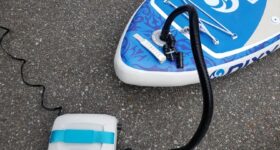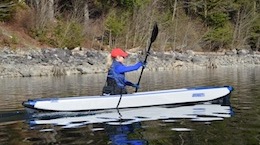
Q. HOW LONG DOES AN INFLATABLE SUP TAKE TO INFLATE?
A. The length of time it takes to inflate your SUP will depend on the type of pump you are using.
With a regular hand pump it will take anywhere from 6 – 10 minutes depending on how fast you pump.
With a good SUP electric pump it will take 6-8 minutes depending on the size of the board.
You ISUP will take shape and inflate really quickly… like in a couple of minutes. Then it just takes a few extra minutes to keep pumping to get it to a higher air pressure. Most inflatable SUP’s should be inflated to 12-15 PSI.
Q. IS THE FIN REMOVABLE?
A. It depends on the board. Some inflatable SUP’s have removable fins and with others they are attached.
Most often there are either three removable fins or one large center removable fin and two attached side fins.
The advantage to having removable fins is that you can customize it for the type of water you are paddling in.
Q. CAN I TAKE MY ISUP ON AN AIRPLANE?
A. Absolutely. One of the great things about inflatable stand-up paddleboards is that they can be taken anywhere, including on an airplane.
They are ideal for traveling as they are so lightweight and compact when deflated.
Some inflatable SUP’s come with a rolling backpack that is easily pulled through the airport like a suitcase. I have traveled with mine quite extensively and never had an issue checking my SUP backpack onto an airplane.
Q.WHAT PSI SHOULD I INFLATE MY BOARD TO?
A. PSI stands for pounds per square inch and refers to the amount of air pressure your board can hold.
Each board will come with a maximum stated air pressure set by the manufacturer.
Although air pressure is not the only factor in the rigidity of your board, it is important and you want to make sure your board has the right air pressure so that it is able to support your weight and perform as it should.
If you are a lighter person, it is not always necessary to have the board inflated to as high of an air pressure.
However most boards should be inflated to 12-15 PSI.
Q. I THINK MY BOARD HAS A LEAK… HOW DO I FIND IT?
A. Most inflatable SUP’s are built quite tough but even so leaks can happen with the best of them.
A leak in the seam is the most common and there is an easy trick to find it.
With your board fully inflated, pour some soapy water over the seams and spread the suds with a rag. Watch for tiny bubbles, that’s where your leak will be.
Q. HOW DO I PATCH A LEAK?
A. Once you’ve found your leak you can now patch it.
Your board will come with a repair kit that includes a small PVC patch and some waterproof glue.
Deflate your board and make sure it is clean and dry. Then apply a generous layer of glue to the area with the leak.
Wait 20 minutes then apply a second coat.
Wait another 20 minutes then apply some glue to the PVC patch and press it firmly onto the board.
Place something heavy on the patch like a weight or a clamp.
Let it sit for 24 hours before inflating the board again. This is a permanent solution that should last a very long time.
Q. HOW DO I CARE FOR MY ISUP?
A. There are only a few things you need to do to properly care for your ISUP.
First make sure it is fully dry before packing it away in its carry bag. This will prevent mold and mildew from forming.
Second, store it in a dry cool area.
Keep it stored out of direct sunlight and away from exposure to the elements, which will just weaken the material over time.
Third, it is a good idea to use a 303 protectant spray once in awhile on your board. This can be bought at any boating store and will protect the material from UV rays.
Q. WHAT KIND OF PADDLE SHOULD I USE?
A. SUP paddles can greatly vary in price. Typically the more expensive paddles are lighter and more specific for proper technique and performance.
As a beginner do not feel that you need to spend a lot on your paddle. It’s really not necessary and hopefully your SUP package came with a paddle to use.
As you get more experienced you may want to upgrade your paddle down the road.
For more details on paddle material, length and blade shape, click here to learn how to choose your stand up paddle.
Q. WHAT ARE THE BASIC SUP PADDLING TECHNIQUES?
A. When you first start paddle boarding the first move you are going to learn is simply to stand up and get comfortable with your stance.
From there you will practice paddling your SUP forward as well as turning. There are a few turning strokes to practice such as the sidestroke, the back paddle and the C stroke.
My advice would be to check out a few YouTube videos to watch these strokes. I find it really helps to see the technique performed on video as opposed to just reading how to do it.
You’ll improve each time you go out!
Q. WHAT HAPPENS IF MY SUP HITS A DOCK OR DEBRIS?
A. Not much is going to happen. Most of these boards are built tough. Hitting a dock or some logs or branches will likely only leave a scuff on your board.
I would suggest staying away from particularly sharp objects or don’t drag the board on gravel.
However as a general rule, ISUP’s can withstand quite a bit of abuse.
Q. HOW LONG WILL AN INFLATABLE SUP LAST?
A. It’s hard to answer that question precisely because it will depend on the amount of use and how well it is taken care of as well as the type of construction.
However it is a safe bet that your ISUP will last for several years if you look after it properly.
Q. WHAT IS THE WARRANTY?
A. The warranty will vary depending on the manufacturer and the quality of the board.
On average inflatable SUP’s have a warranty anywhere from 1 – 3 years.
Q. WHAT KIND OF PFD SHOULD I WEAR?
A. Any PFD is fine. I prefer using a beltpack PFD as I find it more comfortable with less restriction of movement.
However if you are not confident in your swimming abilities then a regular PFD is highly recommended.
Q. CAN I TAKE MY DOG ON MY INFLATABLE SUP?
A. Absolutely. Any dog of any size can go on an ISUP.
A larger dog is obviously going to cause more stability issues than a smaller dog so training before getting on the water is a really good idea.
However there are no concerns with weight or issues from their claws.
In fact an inflatable SUP is ideal and very popular for those who want to bring their dog along because it has more traction for them to keep their balance.
Q. HOW MUCH WEIGHT CAN AN INFLATABLE SUP HOLD?
A. The maximum weight capacity can differ depending on the size of the board.
On average they can hold over 200 lbs., some can hold well over 300 lbs.
Q. HOW DOES LENGTH AND WIDTH AFFECT PERFORMANCE?
A. The longer and more streamlined the SUP, usually the faster and straighter it will go.
Wider boards will be more stable and are great for beginners and paddling in wind and waves.
Q. HOW STABLE ARE INFLATABLE SUP’s?
A. I find inflatable SUP’s to be more stable than a regular fiberglass SUP.
They are great for beginners, for kids, for dogs and for traveling.
Although stability can vary depending on the shape, width and thickness of the board, I find as a general rule they tend to be quite stable and easy to ride.
The thicker 6” boards will definitely be the most stable and are. able to support more weight with no flex.
Q. WHAT ARE THE BEST INFLATABLE SUP’S
A. There are so many different inflatable SUP’s on the market. However there are a few that I really love and paddle most often.
Click here for my list of Top 5 inflatable stand-up paddle boards.
 Sea Eagle Needlenose 126 Racer Review
Sea Eagle Needlenose 126 Racer Review NIXY 10’6” Venice Yoga ISUP Review
NIXY 10’6” Venice Yoga ISUP Review Aquaglide Cascade ISUP Review
Aquaglide Cascade ISUP Review Thurso Surf Expedition Review
Thurso Surf Expedition Review













Hi, is there a type of break-in period for a new inflatable SUP or can you just inflate and go? Thanks!
No break in period necessary. Just inflate and go!
What does the board deflate to? I need precise dimensions for storage purposes
It depends on the board, they are different sizes. However a fairly standard size for a SUP bag packed with the deflated board, paddle, pump, etc is 38″x14″12″.
The top seam at the front of my C4 Waterman iSUP has split – its about 4cm long. I came back from a paddle and had it with me on the beach for 20 minutes when I heard a long hiss and it deflated before my eyes. Can I rejoin the seam with the glue provided or do I patch the whole area including both sides of the seam
Hi Marea, Aw that’s too bad! I would be inclined to do both… glue the seam and then patch the whole area just to be sure no air is getting through. However you might want to take a picture and send it to C4 Waterman to see if they have any additional advice to be sure. Good luck!
Help! I know I’m not alone int this because I have see int happen to many other paddlers when inflating their SUPs. Even though I carefully check the pin is up when I remove the inflation hose the valve button has somehow depressed and locked itself open and I loose all the pressure resetting the valve button. When this happens multiple times in a row as you may imagine I am beat before I ever hit the water. (My board is a high pressure 20 psi model). Especially when I am leading a class and airing up 3 boards.
Any tricks to preventing this? It happens more often when I hurry and pump hard or inflate with a compressor.
Hey Maurice, That is such a pain! Have you tried a different pump? Does the same thing happen with all three boards? I think it is rare but I have had a similar thing happen with a couple of boards over the years. For me it was because the pump attachment didn’t fit the valve perfectly. I had to fiddle with the valve tip so that it didn’t pop so high up. However I’ve never had an issue if I use the pump that came with the board. With my electric pump I have had it not fit the valve very well on a couple of boards, so I know it does happen. I would say when reviewing new boards 99% of them work with multiple pumps. That 1% that doesn’t is frustrating but they seem to be okay with their own designated pumps that came with the package. I wish I had a foolproof tip to help you out. I think your best bet is to contact the board company if it is one particular board that is causing the problem. If it is happening with multiple boards then I think you must have an issue with the pump valve attachment. Sorry I couldn’t help you more!
HI Allison,
I’ve managed to get water inside my inflatable SUP and was wondering if you had any hints or advice on how to remove it because there doesn’t seem to be much online.
Thanks!
Hi Ben, To tell you the truth I’m not sure. Did the water get in through the valve somehow? I’ve never encountered that issue before or even heard of that happening. The only thing I can think of is to actually remove the valve completely and try and get the water out that way. Then you would have to secure the whole valve again. It’s doable although a little tricky. A boating store might be able to help with it. Or you could try contacting the manufacturer to see if they have any ideas. Sorry I couldn’t help you more, good luck!!
I just bought my first ISUP board. I am so excited. It’s pretty hot hear in the summer, Can I store it in my garage while inflated or will the heat damage it?
Hi Renee, Depends how hot your garage gets. I will often leave mine in my garage but there are some days during the summer where my garage is stifling and I usually bring it in at that point. A day or two isn’t a big deal but if your garage gets super hot I’d store it elsewhere to be safe, whether inflated or deflated. Happy paddling!!!
Thanks so much Allison. Is there a guideline for when hot is too hot? Is it over 90, 100?
Again thank you
That’s a good question and I’m not really sure. If you leave it inflated and the garage gets too hot, the air will expand and you can risk over inflation but I’m not sure exactly how many degrees it would need to be. I think if your garage feels stifling it is probably a good indication. If you let a little air out of the board that will help. If you think it might be an issue check with the ISUP company where you bought it, they might have more info.
I blew out my valve on my Solstice Bora Bora ISUP. Any suggestions on how to replace?.
I actually have an old board that needs a valve replacement as well. I haven’t tried to do it yet but it is possible to replace the valve yourself. You will need a valve wrench, which normally is included in the repair kit that comes with the board and a new valve, which you can order on Amazon or possibly straight from Solstice. Here is a video on Youtube that shows the steps… https://www.youtube.com/watch?v=IBQ3E8BoV5Q. There are a few more videos on there as well you could search out. Otherwise you could try calling Solstice… not sure if it is a warranty issue. Or you could take the board to a boat store, particularly one that sells inflatable boats. They can normally fix it as well. Good luck!
Should I store my SUP for the winter inflated in the basement or keep it folded up in the bag?
I store mine folded up in the bag. Just make sure it is totally dried off before stashing it away for the winter. You can leave it inflated if you want to but it is definitely not necessary.
Any do’s or dont’s to look out for when buying one? I’m looking at one where the guy imports them from a factory in China and sells at about 1/2 the price of main brand models.
There are so many ISUP companies popping up and I am finding that many of them are using the same or similar manufacturer in China… Just adding their own decals or slightly different styling. So many of the boards are very similar and basic in design. However the construction seems to be solid. They may not be quite as durable as the well known brands being but overall not too bad. For the cheaper price I would guess it won’t last quite as long but I haven’t had issues with any of them yet. Often the cheaper price will mean no carry bag or a very cheap carry bag and a cheap pump. I would just check out the warranty. Make sure there is at least a one year warranty. If there are any issues with the seams or glue you should notice them right away and a 1-year warranty will at least protect you for a bit.
Why can’t I find any reviews on brands like NRS and ULI?
Hi Matt, they are coming soon. I haven’t had an opportunity to review NRS or ULI yet… I have plans to review a couple NRS boards in the next month or so and hopefully it won’t be too long for ULI. Both great companies and they definitely need to be added. I’m working on it 🙂
Hi there,
I just got myself an ISUP (Solstice Bora Bora) and I wonder if it is OK to leave it inflated under the sun ? I m afraid of the pressure, ie : can the sun heat make the psi jump from 13 to 15 ?
Thing is that I use to have inflatable canoe and protecting them from the sun is always a concern.
Thanks!
Hi Tom, the heat can definitely affect air pressure but in my personal experience I find the heat has to be quite extreme to make much difference. That being said it is advised to store your ISUP out of the sun and away from exposure to the elements. Besides a possible difference in air pressure the UV rays from the sun will wear the material down over time. The inflatable boards these days are pretty tough but if possible store it out of the sun when not in use.
I don’t use paddleboards but I do work at a watersports resort in central Sweden and saw two explode last year after they were left in the sun on a hot day.
Wow it must have been pretty hot for that to happen. Air expands in heat so if the boards are left out in the sun all day and it’s really hot a little air should be let out, especially if the boards were inflated to maximum capacity in the first place. That being said I think exploding boards are pretty rare and they should be stored out of the elements.
These looks really great! What are the inflatable SUP made of? And where are yours made??
Most inflatable SUP’s are made with heavy duty PVC material. We don’t sell them, we only review them.